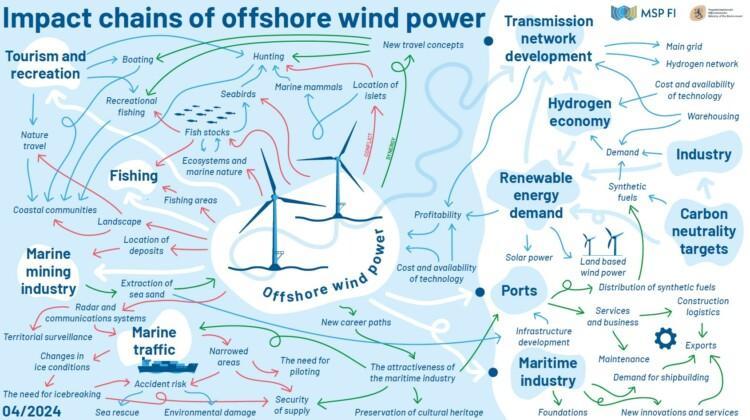Exploring Offshore Wind Power: Current Status, Development Scenarios, and Impact on Maritime Stakeholders
A brand new report from the Finnish Ministry of the Environment describes the current status of offshore wind energy (OWE) development, potential growth scenarios, demand for renewable energy, the need for grid development, and the effects of OWE on other maritime sectors. This up-to-date overview of the development trajectory of OWE supports the revision of Finland’s Maritime Spatial Plan 2030 and sustainable marine use.
Renewable energy plays a crucial role in a green transition and achieving Finland’s climate goals. In the future, OWE can generate a significant amount of renewable energy, including meeting the needs of the green hydrogen economy. However, the construction of OWE has significant impacts that need to be assessed in advance.
”For us at the Ministry, it is important to consider the overall picture of offshore wind power and other maritime activities in maritime spatial planning, so that we can find the most sustainable solutions for coordinating the needs of different sectors,” says Tiina Tihlman, a ministerial adviser from the Ministry of the Environment.

Exploring Finland’s Offshore Wind Power Landscape in 2050
The survey was based on creating alternative development scenarios for Finnish OWE for the years 2035, 2040, and 2050. These scenarios illustrate the situation of OWE depending on whether the development is guided by maritime spatial planning or areas identified by project developers as suitable for OWE production.
The production potential of OWE in 2050 is significant in both scenarios, ranging from 15 to 26 gigawatts. The survey assesses the potential impacts of OWE production according to the development scenarios on maritime sectors such as ports, maritime traffic, marine industry, fishing, fish farming, underwater mining, and tourism.
The survey is based on extensive literature reviews, supplemented by expert interviews and workshops. The work also included a survey targeting coastal residents and recreational users about the social and cultural impacts of offshore wind power.
”The use of marine areas is a matter of common interest for society. National goals are realized in the daily lives of citizens, for example, by changing the recreational use of marine areas, and these changes should be identified in advance. For coordination of maritime activities, it is important to understand where and why conflicts arise,” says Mari Pohja-Mykrä, coordinator of maritime spatial planning cooperation.
According to the results, more information is needed for assessing the cumulative impacts of OWE projects. This requires close international cooperation and providing research funding, for example, through public-private partnerships.
The survey was conducted by Sitowise Ltd., with funding provided by the Ministry of the Environment.
Explore the findings through the following links:




